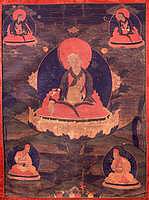
|
Lama Sachen Kunga Nyingpo (painting no. 459)
|

View Larger Image |
||||||||||||||
|
Sachen Kunga Nyingpo, "Lama Sakyapa", first of the five founders of the Sakya lineage. He is shown here with the four following great leaders of this school Sonam Tsemo, Drakpa Gyaltsen, Sakya Pandita Kunga Gyaltsen and Chogyal Phagpa. Together they are referred to as the "three whites and two reds". Red here describes the monastic robes of Sapan and Chogyal Phagpa. M. Mokotoff 12/97 Sachen Kunga Nyingpo (1092-1158): the foremost Lama of the Sakya School. Compassionately smiling with the composure of an elder the right hand is extended forward in the gesture of generosity while the left holds to the heart the stem of a lotus flower blossoming at the left ear. Wearing flowing garments of various colours in the manner of a layman he sits, emanating a blue nimbus and red areola, atop a moon disc and white lotus seat rising on a thick green stem above a blue lotus pond. At the top right is Sonam Tsemo (1142-1182), the eldest son, shown in a youthful manner with long black hair, performing the teaching gesture with the two hands. To the left is Trakpa Gyaltsen (1147-1216), the second son, holding a vajra in the upraised right hand and a bell held in the left and cradled in the lap. At the bottom right is Kunga Gyaltsen (1182-1251), the Sakya Pandita, grandson to Sachen Kunga Nyingpo. With the hands in the teaching gesture at the heart he holds the stems of two utpala flowers blossoming at both ears supporting a wisdom sword and book. Wearing the red hat of a pandit he is attired in the robes of a fully ordained monk. At the left is Phagpa Lodro Gyaltsen (1235-1280), Chogyal Phagpa, the nephew of Sakya Pandita, the first monastic ruler of Tibet. With the right hand raised in the gesture of blessing in the left he holds a Dharma wheel in the lap. Wearing the red pandit hat he also is attired in the robes of a fully ordained monk. Along the bottom are rows of wishing jewels, auspicious and precious objects arranged as offerings. These five as a group are called the ‘Jetsun Gongma Nga’ (the Five Reverend Superiors) of Sakya. The three laymen are known separately as the ‘Karpo Nam Sum’ (the Three White Ones). Sakya Pandita and Chogyal Phagpa are known as the ‘Marpo Nam Nyi’ (the Two Red Ones). At the time of these five lamas the family line which was known by the name ‘Lha Rig’ and ‘Khon’ also became known as Sakya ("Tawney Earth") after the place where Lama Sakyapa had established his monastic center. Jeff Watt 9-98
|
|||||||||||||||
Photographed Image Copyright © 1998 Shelley & Donald Rubin Foundation
|
|
| |
Next Image |